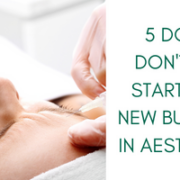Emma Davies, Clinical Director of Save Face, reviews the background to the current regulatory framework in the aesthetics industry, exploring its weaknesses and makes a case for voluntary self regulation for non-surgical cosmetic interventions, based on government reviews, reports and strategic policy.
Introduction
“You are where you are right now because of the actions you’ve taken, or maybe, the inaction you’ve taken.” ― Steve Maraboli, Life, the Truth, and Being Free.
Why does this topic go round and round? We are faced with an unacceptable and apparently overwhelming web of political, regulatory, commercial and professional conflicts to unify in order to focus and succeed in protecting public safety.
Background
This field of practice is quite unique. Though medical in nature, there is no provision, nor ever has been, in the NHS, which has left training provision and standards to evolve organically and without recognised accreditation. The client base is healthy and treatment is a choice rather than a necessity. Unlike other medical procedures, it is possible to provide these in a variety of venues with relatively low capital cost and overheads.
Because of the association with beauty the vanguard of early adopters commonly provided services in association with beauty salons, chartering new territory without reference to any expert authority to interpret and apply regulation developed with accountable institutions in mind. It is no small wonder, given the exponential growth of the market, and the commercial gains to be made, that providers from a wide variety of backgrounds have exploited the apparent loop holes in legislation and regulation and seized the opportunities to practice with apparent impunity. The resulting diversity of practice and growing accessibility of services, left unchecked for over two decades, has led us where we are today.
Non-surgical cosmetic services may be provided by ANYONE, ANYWHERE and where legislation and regulation are breached, sanctions are not robustly applied and fail to deter.
It is reliably estimated there are some 7000 providers in the UK alone. Approximately 800 belong to professional associations (e.g.BCAM/BACN/BAD) providing influence, guidance and political representation on standards and education related specifically to Aesthetic Medicine. This suggests there are thousands who don’t know what they don’t know and likely do not care.
The Case Against More Statutory Regulation
In 2011 the Prime Minister, in a letter to Cabinet ministers said, “We need to tackle regulation with vigour to free businesses to compete and create jobs, and give people greater freedom and personal responsibility …I want us to be the first Government in modern history to leave office having reduced the overall burden of regulation, rather than increasing it.”
It is quite wrong to complain that this field of practice is entirely unregulated. Every aspect of practice falls under regulation, however the framework is complex, expensive and unable to adapt quickly to new challenges.
“..regulators are frequently unable to make important changes that would allow them to improve their performance, work less bureaucratically, reduce costs to registrants and respond more fairly and effectively to both public and professional concerns. The current legislative framework over-regulates the regulators themselves by constraining their freedom to adapt and modernise.” (DOH, 2011)
The statutory professional regulators are largely dependant on the cooperation of employers/ providers in managing concerns at a local level, but some 28% of regulated health and social care professionals for whom data is available, work in the private sector, many in a self employed capacity. The regulators are too distant from where the risks arise to be able to act proactively and preventatively in all circumstances and an over reliance on centralised regulation, weakens local responsibility for good governance mitigating risk and managing complaints. (DOH, 2011)
Legislation which applies to our practice isn’t specific to the practice of Aesthetic Medicine which explains the necessity for the layers and devolution of responsibilities, accountabilities, overlap and gaps.
This overlap and duplication of accountability and responsibility leads to confusion and pillar to post reactions to concerns raised. Leaving the individual victim at a loss. The case of Maria McGinty being one in point. The victim, not equipped or expert in navigating the web of regulations and regulators in place for her protection had nowhere to turn.
Post-Keogh, the government measured the value, cost and impact of instigating and enforcing yet more legislation. It has called upon the regulators (primarily the MHRA, GMC, NMC and GDC) to examine what more they can do in line with the responsibilities they have under statute, and there is an expectation that non-medical, non-prescribing practitioners will (voluntarily) work under the supervision of regulated and accountable practitioners. (DOH, 2014)
National Diversity
“The Destiny of Man is to unite, not to divide. If you keep on dividing you end up as a collection of monkeys throwing nuts at each other out of separate trees.”― T.H. White
In England, The Healthcare Commission charged with inspecting, regulating and auditing the NHS, private healthcare and voluntary organisations, was replaced by The Care Quality Commission in 2009, and in 2010, provision of non-surgical cosmetic services was excluded from the scope, presumably, because its impact was negligible and the cost proved prohibitive. Like many regulators, their remit is clear, but their scope is diverse; hospitals, care homes, private health services, GPs, dentists. The annual cost to the tax payer is £110M and the CQC will have to be cost neutral by 2016. The £230M annual budget will have to be met by registration fees. (Secretary of State for Health, 2011)
The Public Health Bill (Wales, 2015) proposed licensing for special treatments; tattooing, body piercing, acupuncture and electrolysis. The inclusion of dermal fillers and botulinum toxin at a later date is not completely ‘off the table’ and no new legislation would be required for them to expand the list of ‘special procedures’, but the licensing would be entirely inclusive. (Welsh Government, 2015)
This year (2016) Scotland is implementing regulation for private clinics where services are provided by healthcare professionals within the scope of Healthcare Improvement Scotland (HIS). The definition of an independent clinic in terms of the National Health Service (Scotland) Act 1978, are clinics that are not part of a hospital and from which a medical practitioner or dental practitioner provides a service, which is not part of the national health service. The term “service” includes consultations, investigations and treatments. Currently the regulation of any other staff group (eg. beauty therapists) other than those indicated above, is not included in the Bill. (SCIEG, 2015) It is proposed that providers of cosmetic procedures, who are not covered by HIS, will be licensed by local authorities, the details of when and how have not yet been determined. In only including healthcare professionals it patently fails to address the risks and we are likely to see many unintended consequences, detrimental to public health and safety.
The Case for Voluntary Self Regulation
“The principal purpose of regulation of any healthcare profession is to protect the public from unqualified or inadequately trained practitioners. The effective regulation of a therapy thus allows the public to understand where to look in order to get safe treatment from well-trained practitioners in an environment where their rights are protected. It also underpins the healthcare professions’ confidence in a therapy’s practitioners and is therefore fundamental in the development of all healthcare professions.” (House of Lords, 2005)
Everyone had high hopes for a positive change to come from The Keogh Report and there was wide spread disappointment, if not despair once the recommendations and government response were published in July, 2014.
Continuing to call for greater regulation is an emotional rather than an intellectual demand. There is no perfect fix for the risks to the public and the practitioners who treat them. The commercial imperative and market forces will constantly shift and evade any legislation or regulation and budgets, manpower and priorities will always limit the impact of any such regulation.
We may take one of two positions. Either we consider ourselves hopeless and helpless in the absence of further targeted statutory regulation, or we apply ourselves to the gaps and the distance and consider how we might address them through voluntary co-(self) regulation. We must focus on what we can achieve rather than accept defeat and allow the ‘market’ to be driven by the lowest common denominators. Let us take ownership of the SAFE, responsible, credible, ethical and professional and draw a line in the sand between best practice and the shameful headliners, which embarrass and frustrate us.
The ‘distance’ lies between the consumer/patient and the statutory regulators. But also between the unaccountable practitioner ,self employed in private practice, and the regulators. The ‘gaps’ lie in the lack of credible, objective data to inform regulation, the paucity of public and media education and the lack of direct accountability; of the provider to the patient, when things go wrong. We need to close the distance and seal the gaps. These are not insurmountable challenges.
A Way Forward
“Success is determined not by whether or not you face obstacles, but by your reaction to them. And if you look at these obstacles as a containing fence, they become your excuse for failure. If you look at them as a hurdle, each one strengthens you for the next.”― Ben Carson, Gifted Hands: The Ben Carson Story.
If nothing else, Keogh and HEE have given us experience of working together and insight into our shared challenges and concerns. Since it now seems unlikely that any of the recommendations will be mandated by statute, there is a real danger that the reality of the current landscape (the public making unsafe choices and unsafe, unethical practice flourishing with impunity) will not improve for the better in any meaningful way.
In February 2011, the Government published the Command Paper ‘Enabling Excellence – Autonomy and Accountability for Healthcare Workers, Social Workers and Social Care Workers’. This document sets out the current Government’s policy on regulation, including its approach to extending regulation to new groups. In particular, it sets out the Government’s policy that, in the future, statutory regulation will only be considered in ‘exceptional circumstances’ where there is a ‘compelling case’ and where voluntary registers, such as those maintained by professional bodies and other organisations, are not considered sufficient to manage the risk involved.
The paper also outlines a system of what is called ‘assured voluntary registration’. The Health and Social Care Act 2012 has implemented a number of the policies described in the Command Paper. The Professional Standards Authority for Health and Social Care now has powers to accredit voluntary registers of people working in a variety of health and social care occupations. The idea behind this, to provide assurance to the public that these registers are well run and that they require their registrants to meet high standards.
It is our duty to work towards achieving fit for purpose self regulation. In the select committee report it was recommended ‘that, in order to protect the public, professions with more than one regulatory body make a concerted effort to bring their various bodies together and to develop a clear professional structure.’ (Stone Report, 2005)
In working towards effective regulation for complimentary and alternative therapies, a federal structure was explored and determined, and we might take inspiration and heart from their journey and success (PFIH, 2006) (House of Lords Select Committee, 2002).
When considering the options for Complimentary Alternative Medicine (CAM) a great deal of work was undertaken, the author has identified a great deal of commonalities and rather than ‘reinvent the wheel’, refers the reader directly to the documents already published, to describe the risks and benefits of a Federal Structure from which to base a sound framework for self regulation in Cosmetic Medicine.
Health Education England published its final report in January 2016 and proposed a new landscape which included; A Joint Council (inclusive of ALL stakeholders) to establish a competent authority to oversee and accredit new education and training standards in line with the proposed educational framework, and an independent register accredited by The Professional Standards Authority (PSA).
Whilst the government support inclusion (of beauty therapists etc), The PSA only regulates registers of health and social care registers, including the statutory bodies. Given that none of the proposals are mandated by legislation, the author would entreat the professional bodies to focus on expediting progress addressing the issues faced by regulated healthcare professionals, primarily that of appropriately accredited education and training. Whether or not progress is made on an inclusive Joint Council, which they may also be part of.
- A Federation to unify the regulated healthcare professionals (nurses, doctors, dentists and prescribing pharmacists) (HEE, 2012) and foster collaboration to minimise duplication of activity and resources.
- The Professional Associations to represent, educate and support the individual professional groups
- A single independent register to accredit those who meet the standards set by The Federation- undertaking verification and inspection and providing a direct connect with, and accountability to, the consumer.
Joined up – we have a real chance of educating and supporting patients to make safer choices and strengthen the credibility of the regulated professionals providing these services.
Save Face, in just over 12 months have demonstrated how much can be achieved with a ‘can do’ attitude. This work and achievement has required significant risk and investment- in excess of £500,000 to date. It has delivered credible standards, published policies, procedure protocols, patient information and consent forms, guidelines and CPD accredited learning to support best practice and mitigate risk. Unlike any other register of non-surgical cosmetic service providers, it verifies each accredited practitioner- registration, training, insurance and CPD and inspects every premises accredited. It provides guidance, information and resources to support best practice standards and most importantly, it encourages and facilitates patient feedback and when concerns are raised or complaints made, it ensures fair and professional resolution.
Ultimately, the consumer drives and shapes the market. Whatever regulation is in place, the public does not fully benefit unless it is well informed and motivated to make safe choices. Website SEO, blogs, engagement on social media, local and national campaigns and working with journalists are all an essential part of this, but behind every story, the offending practitioner must be held accountable to the regulations in place, and made an example of. Independent of political and professional agendas, Save Face has focussed entirely on the needs of the risk averse consumer. It has strategically invested and acted to build awareness of not only the register, but to rock the assumption that nothing can be changed.
Having examined numerous government reviews and reports, and in particular, The Hampton Review (Hampton, 2004) the author is confident the model Save Face presents is not only fit for purpose, and PSA accreditation will give assurance of that, but represents the best way forward for regulated healthcare professionals specialising in non-surgical cosmetic practice. There is great potential for real progress if only we all joined forces and harmonised from a single hymn sheet rather than singing individual tunes to smaller audiences.



 Mobile Friendly – more than half of websites are visited using a mobile, its important to make sure your website can be used on all platforms effectively and efficiently.
Mobile Friendly – more than half of websites are visited using a mobile, its important to make sure your website can be used on all platforms effectively and efficiently.













